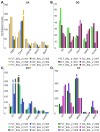Spaceflight-Induced Gene Expression Profiles in the Mouse Brain Are Attenuated by Treatment with the Antioxidant BuOE
- PMID: 37686374
- PMCID: PMC10487739
- DOI: 10.3390/ijms241713569
Spaceflight-Induced Gene Expression Profiles in the Mouse Brain Are Attenuated by Treatment with the Antioxidant BuOE
Abstract
The demands of deep space pose a health risk to the central nervous system that has long been a concern when sending humans to space. While little is known about how spaceflight affects transcription spatially in the brain, a greater understanding of this process has the potential to aid strategies that mitigate the effects of spaceflight on the brain. Therefore, we performed GeoMx Digital Spatial Profiling of mouse brains subjected to either spaceflight or grounded controls. Four brain regions were selected: Cortex, Frontal Cortex, Corunu Ammonis I, and Dentate Gyrus. Antioxidants have emerged as a potential means of attenuating the effects of spaceflight, so we treated a subset of the mice with a superoxide dismutase mimic, MnTnBuOE-2-PyP 5+ (BuOE). Our analysis revealed hundreds of differentially expressed genes due to spaceflight in each of the four brain regions. Both common and region-specific transcriptomic responses were observed. Metabolic pathways and pathways sensitive to oxidative stress were enriched in the four brain regions due to spaceflight. These findings enhance our understanding of brain regional variation in susceptibility to spaceflight conditions. BuOE reduced the transcriptomic effects of spaceflight at a large number of genes, suggesting that this compound may attenuate oxidative stress-induced brain damage caused by the spaceflight environment.
Keywords: brain; digital spatial profiling; gene expression; regional difference; spaceflight.
Conflict of interest statement
The authors declare no conflict of interest.
Figures






References
-
- Villasana L.E., Rosenthal R.A., Doctrow S.R., Pfankuch T., Zuloaga D.G., Garfinkel A.M., Raber J. Effects of alpha-lipoic acid on associative and spatial memory of sham-irradiated and 56Fe-irradiated C57BL/6J male mice. Pharmacol. Biochem. Behav. 2013;103:487–493. doi: 10.1016/j.pbb.2012.09.021. - DOI - PMC - PubMed
MeSH terms
Substances
Grants and funding
LinkOut - more resources
Full Text Sources
Molecular Biology Databases
Miscellaneous

